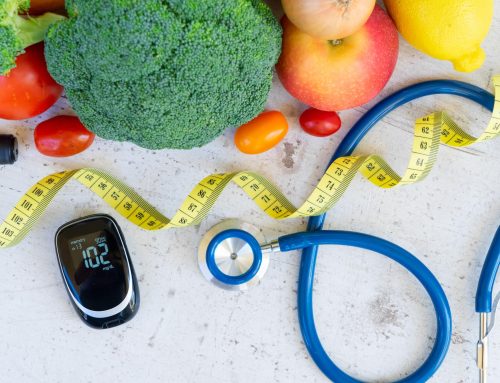It’s International Men’s Health Week 11-17 June. The focus this year is on diabetes and why men are more at risk of developing this than women. Here Dr Scott, an experienced GP at our private Shenfield practice, looks at type 2 diabetes in more detail and explains what you can do to decrease your risk.
What is diabetes?
Diabetes is a serious disease which prevents the body from keeping sugar levels within a healthy range. This is due to a problem with a hormone called insulin, which normally works to regulate sugar levels. The result, high levels of sugar in the blood stream.
There are two types of diabetes: Type 1 and Type 2.
Type 1 diabetes is an autoimmune condition where the body destroys cells in the pancreas which produce insulin, it is usually diagnosed in children of young adults.
Type 2 diabetes is associated with being overweight and is usually diagnosed in people over the age of 40. It is more common that type 1 diabetes and accounts for 90% of cases of diabetes. In type 2 diabetes either the body stops making enough insulin or becomes less sensitive to the effect of the insulin it makes.
What is the scale of the diabetes problem?
In 2017 there were 3.7 million people with diabetes in the UK and this is predicted to rise to 5 million by 2025. It is estimated that 1 in 10 men will develop diabetes.
That diabetes is the focus of 2018 International Men’s Heath Week demonstrates the seriousness of this global health issue and the facts are impossible to ignore.
Men are more likely to get diabetes. More likely to suffer complications. More likely to face amputation as a result of diabetes. More likely to die from diabetes. Much more needs to be done. One man in 10 now has diabetes and in middle-aged men the disease is expected to increase sharply in frequency over the next 20 years.
Find out more and join the campaign #MHW2018
What are the symptoms of diabetes?
Diabetes causes symptoms such as fatigue, unintended weight loss, needing to pass urine a lot, feeling very thirsty and frequent infections. If left untreated or uncontrolled for a long period of time, high sugar levels in the blood can lead to damage to the small blood vessels (capillaries). This can lead to problems at the back of the eyes, causing blindness; in the heart, causing heart disease; in the kidneys; and around the nerves, causing numbness.
Diabetes also puts you at greater risk of having other problems such as high blood pressure, stroke, high cholesterol and heart attacks.
How can diabetes be treated?
Type 1 diabetes is treated with injections of insulin and a healthy diet.
Type 2 diabetes can be improved by weight loss if you are overweight and diet to keep sugar levels low. If this approach fails to result in satisfactory diabetic control there are medications to treat type 2 diabetes including tablets and also injections.
What are the risk factors for developing type 2 diabetes?
- Obesity (having a body mass index – BMI of over 30) is thought to account for 80-85% of the risk of developing type 2 diabetes.
- Having a close relative with diabetes such as a parent, brother or sister.
- Some racial groups are at greater risk of developing diabetes such as people of South Asian, Chinese, African Caribbean or Black African origin.
- Age – you are more at risk over the age of 40 if you are white, or over the age of 25 if you are African-Caribbean, Black African, or South Asian.
- High blood pressure
- High cholesterol
Why are men more at risk of type 2 diabetes?
Studies have shown that at a given BMI, men are less sensitive to the effect of insulin than women. This means that men have to gain less weight than women in order to develop diabetes and therefore they are more likely to develop type 2 diabetes at a lower weight than women.
It is thought that one of the reasons for this is that men and women have different distributions of fat. In general women lay down fat around their hips and bottoms and men lay it down around their tummy (abdomen).
Abdominal fat is thought to be the more dangerous as it causes fat cells to release inflammatory chemicals which can disrupt the function of the cells which normally respond to insulin. This can therefore make the body less sensitive to the insulin it is producing and so lead to an increased risk of developing diabetes.
In addition, middle aged men generally have higher fasting glucose and cholesterol levels than women of a similar age which also increases their risk of diabetes.
Can I reduce my risk of developing type 2 diabetes?
YES YOU CAN! Studies have shown that changing your lifestyle can reduce your risk of developing Type 2 diabetes.
Exercise: 30 minutes a day on most days of the week (it could be broken down into three 10 minute chunks or two 15 minute chunks) of moderate activity (any activity that makes you feel slightly breathless and increases your heart rate). If you are someone that does not do much exercise you might need to start slowly and gradually build up how much exercise you are able to do.
Weight: Your risk of developing Type 2 Diabetes increases if you are overweight. To lose weight you can try reducing your portion size, choosing low calorie snack options, using less oil to cook with and cooking your meals from scratch rather than eating ready meals and take-aways.
Diet: Choose low fat options and eat more fibre (fruit, vegetables, wholegrain cereals/rice/pasta, oats and lentils). Look at food labels – lots of foods have a traffic light system on the front to help you make healthy choices at a glance.
Stopping smoking and reducing your alcohol intake to safe levels can also reduce your overall risk of heart attack and stroke.
Diabetes can be diagnosed by a blood test which we can conduct at our private GP surgery in Shenfield. If you are concerned about your risk of diabetes, or the risk diabetes poses to a loved one, please call our helpful reception team on 01277 201001. They will be happy to help you to make an appointment with one of our doctors to discuss your concerns.
We also offer Well Man and Well Woman health screening which can help detect diabetes early before complications occur.
If you develop any of the following symptoms it is important to make an appointment to see a doctor as they might indicate Type 2 diabetes: feeling tired, needing to go to the toilet to pass water more often, feeling thirsty, more infections, blurred vision and weight loss.
References
https://www.nhs.uk/conditions/type-2-diabetes/
https://patient.info/health/diabetes-mellitus-leaflet
https://www.ncbi.nlm.nih.gov/pmc/articles/PMC4890267/
Logue, J., Walker, J.J., Colhoun, H.M. et al. Diabetologia (2011) 54: 3003. https://doi.org/10.1007/s00125-011-2313-3






